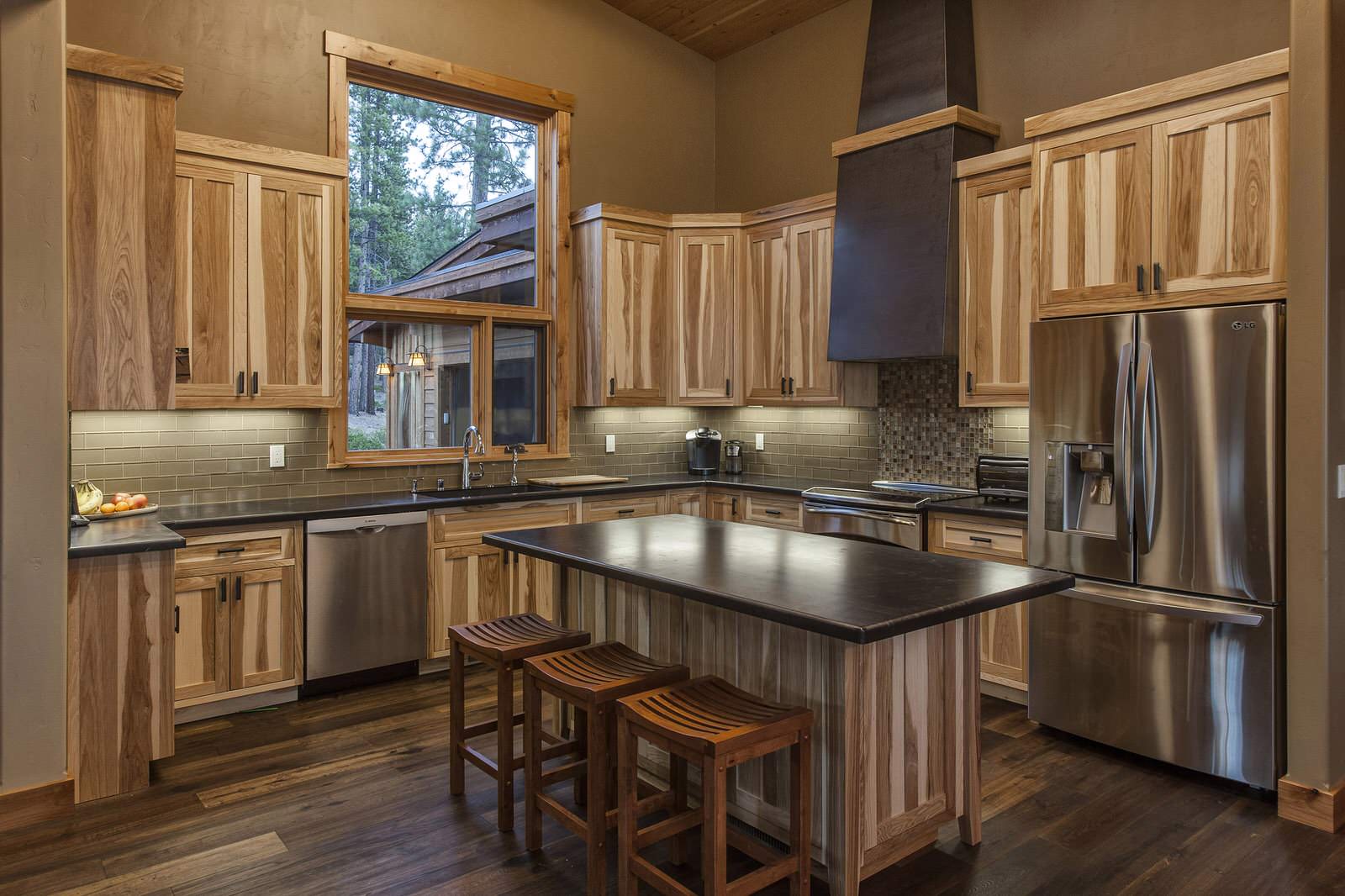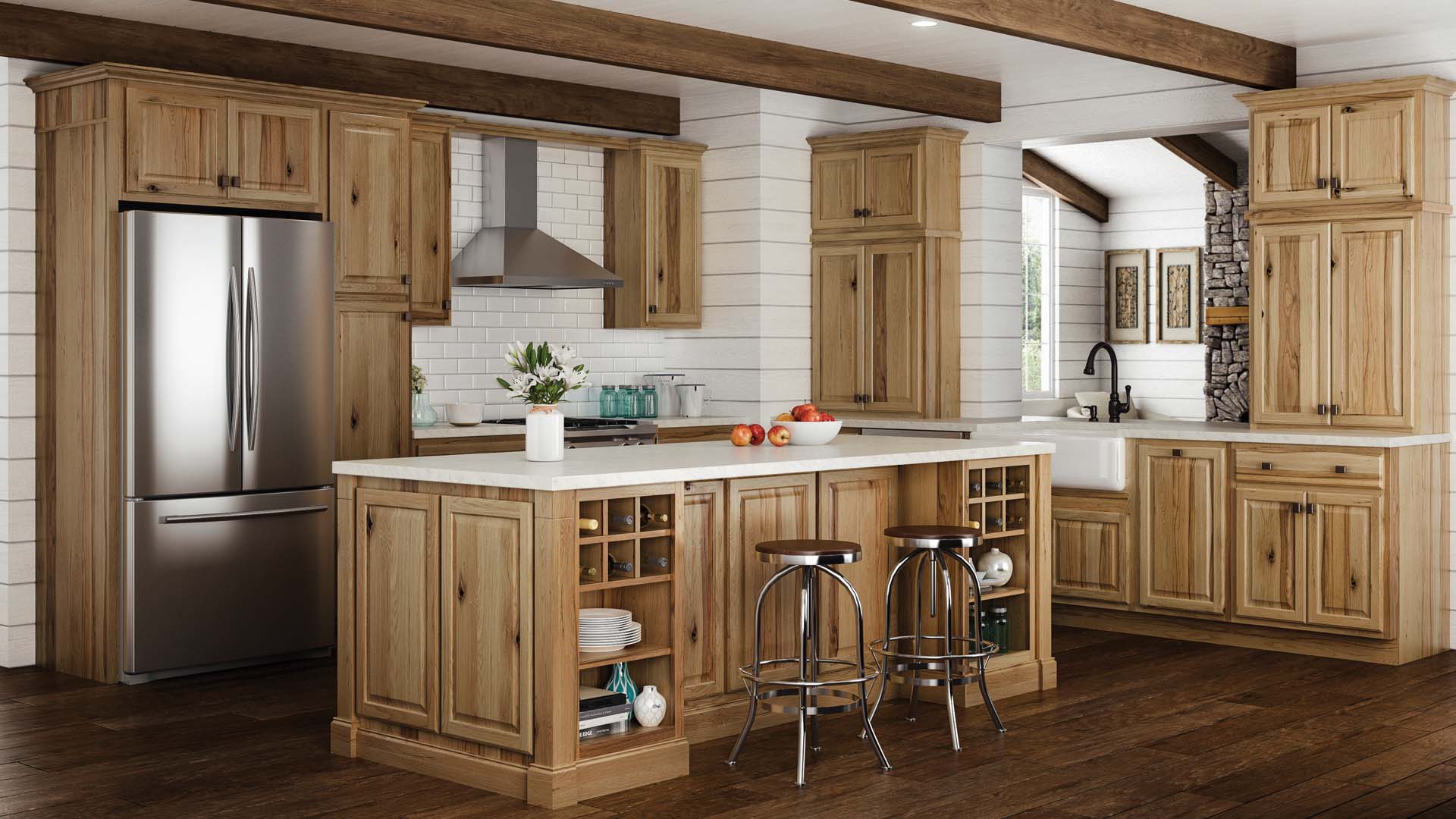Hickory Cabinet Characteristics

Hickory cabinets are a popular choice for homeowners due to their unique beauty and durability. Hickory wood is known for its distinctive grain patterns and rich color variations, adding character and warmth to any kitchen or bathroom. These natural variations, however, also play a significant role in countertop selection, as the right countertop should complement the hickory cabinets and create a cohesive design.
Hickory Wood Variations and Their Impact on Countertop Selection
The natural variations in hickory wood color and grain patterns can significantly influence countertop choices. Hickory wood ranges from light blonde to dark brown, with shades of red, pink, and even purple sometimes appearing. The grain patterns can be straight, curly, or knotty, creating a unique visual appeal.
- Light Hickory: Light hickory cabinets with a subtle grain pattern can be paired with a wide range of countertop materials, including light-colored quartz, granite, or marble. These countertops will complement the light wood without overpowering it.
- Dark Hickory: Dark hickory cabinets with prominent grain patterns are best paired with darker countertops, such as black granite, dark quartz, or even a dark-toned wood countertop. These darker countertops will create a dramatic contrast with the hickory and add depth to the space.
- Rustic Hickory: Rustic hickory cabinets with knots and character marks often have a warm, inviting feel. These cabinets can be paired with a variety of countertop materials, including rustic stone, reclaimed wood, or even concrete. The countertop should complement the rustic character of the cabinets and create a cohesive design.
Hickory Cabinet Styles and Countertop Choices, Countertops that go with hickory cabinets
The style of hickory cabinets also plays a role in countertop selection.
- Traditional Hickory Cabinets: Traditional hickory cabinets often feature a classic design with detailed moldings and carvings. These cabinets are best paired with traditional countertop materials, such as granite, marble, or soapstone. These materials complement the classic style of the cabinets and create a timeless look.
- Modern Hickory Cabinets: Modern hickory cabinets often feature clean lines and minimalist designs. These cabinets are best paired with modern countertop materials, such as quartz, engineered stone, or even concrete. These materials complement the modern style of the cabinets and create a sleek and contemporary look.
- Rustic Hickory Cabinets: Rustic hickory cabinets often feature a distressed or weathered look. These cabinets are best paired with rustic countertop materials, such as reclaimed wood, concrete, or even slate. These materials complement the rustic character of the cabinets and create a warm and inviting atmosphere.
Countertop Material Options: Countertops That Go With Hickory Cabinets

Choosing the right countertop material for your hickory cabinets is a crucial decision that impacts both the aesthetics and functionality of your kitchen. You want a material that complements the warm tones and rustic charm of hickory, while also offering durability, practicality, and style. This section explores popular countertop options, comparing their advantages and disadvantages, to help you make an informed choice.
Comparing Countertop Materials
The choice of countertop material depends on your preferences, budget, and lifestyle. Here’s a breakdown of popular options, highlighting their pros and cons in relation to hickory cabinets:
Granite
Granite is a natural stone known for its durability, heat resistance, and unique patterns.
- Pros:
- Durable and scratch-resistant.
- Heat-resistant, making it ideal for hot pots and pans.
- Unique patterns and colors that complement hickory’s warm tones.
- Can be sealed to resist stains.
- Cons:
- Can be expensive.
- Requires regular sealing to maintain its beauty and protect against stains.
- Porous, so it can be susceptible to etching from acidic substances.
- Heavy, which can put stress on cabinets.
Quartz
Quartz is an engineered stone made from crushed quartz crystals and resin. It offers the look of natural stone with enhanced durability and low maintenance.
- Pros:
- Non-porous, making it highly resistant to stains and bacteria.
- Durable and scratch-resistant.
- Wide range of colors and patterns to match any style.
- Low maintenance, requiring minimal sealing.
- Cons:
- Can be expensive, though often less than granite.
- Can be susceptible to heat damage, so using trivets is recommended.
- May not have the same natural beauty as granite.
Laminate
Laminate is a synthetic material made from layers of paper impregnated with resin. It’s a budget-friendly option that offers a variety of styles and colors.
- Pros:
- Affordable.
- Wide range of colors and patterns, including wood-look options that complement hickory cabinets.
- Easy to clean and maintain.
- Cons:
- Not as durable as natural stone or quartz.
- Susceptible to scratches and heat damage.
- Seams can be noticeable, especially in high-traffic areas.
Butcher Block
Butcher block is made from solid wood, typically maple or walnut. It’s a durable and practical choice for kitchens that see a lot of food preparation.
- Pros:
- Durable and scratch-resistant.
- Naturally antibacterial.
- Provides a warm and rustic look that complements hickory cabinets.
- Can be refinished to remove scratches and blemishes.
- Cons:
- Requires regular oiling to maintain its beauty and prevent drying.
- Susceptible to water damage if not properly sealed.
- Can be expensive, especially for larger countertops.
Countertop Material Comparison Table
| Material | Pros | Cons | Cost |
|---|---|---|---|
| Granite | Durable, heat-resistant, unique patterns | Expensive, requires sealing, porous | High |
| Quartz | Non-porous, durable, low maintenance | Expensive, heat-sensitive | High |
| Laminate | Affordable, wide range of styles, easy to clean | Not as durable, susceptible to scratches and heat | Low |
| Butcher Block | Durable, antibacterial, rustic look | Requires oiling, susceptible to water damage | Medium |
Color and Style Considerations

Choosing the right countertop color and style for your hickory cabinets is a crucial step in creating a cohesive and visually appealing kitchen. Hickory’s unique grain patterns and warm tones offer a versatile backdrop for various countertop options, allowing you to personalize your kitchen’s aesthetic.
Countertop Color Palettes
Hickory cabinets, with their rich, warm tones, lend themselves well to a variety of countertop color palettes. Here are some popular choices:
- Warm Neutrals: Cream, beige, and light gray countertops create a timeless and sophisticated look, complementing the warmth of hickory while providing a neutral backdrop for other kitchen elements. Think of creamy white quartz or a light beige granite with subtle veining.
- Earthy Tones: Brown, tan, and green countertops create a natural and inviting ambiance. Consider a warm brown granite with gold flecks or a green marble with subtle veining. These colors harmonize with the earthy tones of hickory, creating a cohesive and grounded look.
- Bold Accents: For a more dramatic look, consider black or dark gray countertops. These colors create a striking contrast against the warm tones of hickory, adding a touch of sophistication and drama to the space. A black honed granite or a dark gray quartz with subtle sparkle can create a stunning visual impact.
Countertop Patterns and Styles
Countertop patterns and styles play a significant role in determining the overall aesthetic of your kitchen.
- Solid Colors: Solid color countertops provide a clean and minimalist look, allowing the hickory cabinets to take center stage. These are often found in quartz or engineered stone and come in a wide range of colors.
- Veined Patterns: Veined patterns, typically found in granite and marble, add visual interest and depth to the countertop. These patterns can be subtle or dramatic, depending on the specific stone. Look for a countertop with veining that complements the grain patterns of your hickory cabinets, creating a harmonious and cohesive look.
- Textured Finishes: Countertop finishes can significantly impact the overall aesthetic. Polished finishes create a sleek and reflective look, while honed finishes provide a more matte and understated appearance. Matte finishes offer a soft and subtle look, often preferred for a more casual or rustic feel.
Countertops that go with hickory cabinets – Hickory cabinets, with their warm, rustic charm, invite a range of countertop options. From the sleek elegance of granite to the timeless appeal of butcher block, the possibilities are endless. And just as the right countertop complements your cabinets, so too does the right wall covering enhance your bedroom’s ambiance.
Consider the softness and warmth of fabric covered walls for a truly inviting retreat. Similarly, the perfect countertop choice for your hickory cabinets will complete the look and feel of your space, creating a haven that speaks to your unique style.
Hickory cabinets, with their warm, rustic charm, can be paired with a variety of countertops. A popular choice is a light-colored countertop, such as a creamy white or a soft beige, which creates a sense of airy spaciousness. If you’re looking for a touch of elegance, consider the timeless beauty of cream kitchen cabinets with wood countertops , a combination that exudes sophistication.
For a bolder look, a dark countertop like black granite or a deep brown quartz can provide a dramatic contrast against the hickory’s rich grain.